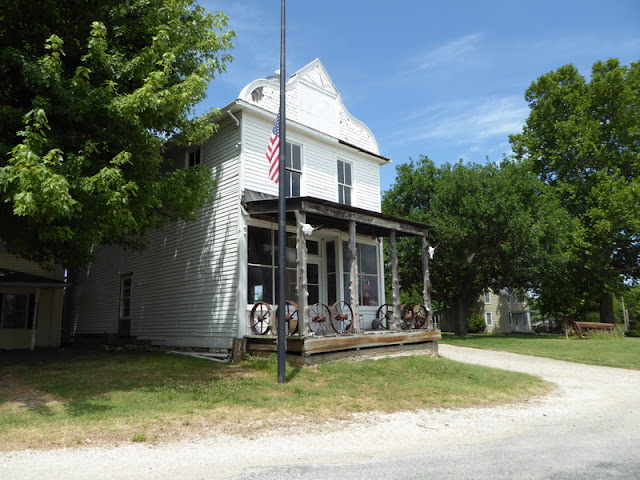We finally have a good internet connection and I'm going to fill in some things we did while we were in Illinois. As mentioned in the previous posting we stayed at Beaver Dam State Park since all (very few) campgrounds in the area were full. There is a large pipe-line project going through the area and the workers have taken all the campsites and most of the hotel rooms.
Our good friends Gloria & Doug were parked at her brother's home about a mile away from us and we made plans to drive down to Hardin, IL on the Illinois River for a catfish lunch. The Barefoot Restaurant is right on the river and doesn't look like much from the outside, but they serve a great catfish dinner for a very reasonable price. Gerry and I had the lunch special of a large catfish sandwich and cole slaw for $6.99 and draft beer for $1.25. (Yes, we do love catfish) They recently went up on the beer 25 cents. The meal was large and very good. Gloria & Doug had the catfish fritter dinner and it was so large they couldn't finish it. Gooood eating!
Hardin in Calhoun County, IL is bordered by the Illinois and Mississippi rivers. It's location made it isolated for many years until the Joe Page bridge was built making it more accessible to the rest of Illinois.
Calhoun County is noted for it's orchards and fantastic peaches. When I lived in Illinois I was a big fan of the softball size peaches from there. My father used to drive there in his van and pick up 20-30 bushels of peaches and take them back to Gillespie and sell them. That was his idea of how to spend his vacation time from his full-time job.
Looking down on Hardin main street from the old cemetery on the hillside with a view of the Illinois River.
Calhoun County, like Jo Daviess County in northwest Illinois, is unique in the state in that glaciers didn’t touch it and therefore has a more rugged terrain that is dissected by valleys than the generally flat terrain associated with the rest of Illinois. Calhoun County is also located at the tip of the peninsula formed by the Mississippi and Illinois Rivers and is almost completely surrounded by water. Brussels is located near the southern tip of the peninsula on a fertile ridge top with some shallow valley slopes that makes it a suitable site for farming and orchards. German immigrants first settled this small country village in 1822 that were attracted by the fertile land that had an adequate water supply and nearby forests that provided wood for construction and fuel. The lack of any railroads or bridges into Calhoun County has meant that Brussels has always been sparsely populated with a population never reaching greater than several hundred, allowing it to retain the feeling of a small but active agricultural community of the late 19th and early 20th century.
We took the free Brussels ferry ride back across the Illinois River and enjoyed the short boat ride.
The Mississippi & Illinois rivers join at Grafton, IL. The flood of 1993 damaged the town so much that 1/3 of the population left and never returned.
There were settlers in Grafton as early as 1812 so I'm not sure what the birthday cake shown below stands for. It was an impressive cake though.
Bluffs along the Great River road near Grafton, IL. This road is flooded out often when the Mississippi river floods. It is a beautiful drive with the bluffs on one side and the river on the other.
The area is noted for it's Bald Eagle population that nest and winter in the area.
During
the flood of 1951 the Mississippi River had risen so high that it threatened
Portage des Sioux for the first time in the history of the town. In a 1957
article The St. Charles Banner-News reported:
“While the streets of
many riverbank communities disappeared beneath the rising waters, something
important was happening in Portage des Sioux, Mo. Father Edward B.
Schlattmann, pastor of St. Francis Church, called upon his parish Legion of
Mary to pray to the Blessed Virgin. For the first time anywhere, Mary’s
protection was sought under the appellative, “Our Lady of the rivers.”
The surging current swept over the roads leading into Portage and lapsed
hungrily toward the town. Isolated and frightened, Portage people watched
helplessly as the water inched nearer their homes. After two weeks, when the
flood finally crested, their community was mostly high and dry.”
In gratitude, the
parish decided to erect a statue on the banks of the river, dedicated to
“Our Lady of the Rivers.” Word of the project spread, and contributions
came in from all over the United States. In October 1957, ten thousand
people attended the dedication of a 25-foot fiberglass statue of Mary
mounted on a 20-foot concrete pedestal that sits at the water's edge looking
across the Mississippi to the bluffs above Alton, Illinois.
The
annual tradition of the Blessing of the Fleet in July soon followed. Hundreds of
decorated boats gather from miles around to receive a blessing from the town
priest asking for Mary's intercession to protect their vessels from harm.
After the blessing the boats parade up the river to the nearby town of
Grafton, Illinois.
Our trip was cut short by a bad accident on the Great River road and we took a detour around the accident. The driver of a Jeep lost control and flipped over. It took a long time to clear the accident. By this time we had enough of driving and headed back to our campground. I always enjoy the drive down in that area and look forward to making the trip again.
That was our day, how was yours?












We enjoyed our visit. Safe travels. Hope you have some more interesting places to describe as you make your way back to the cabin.
ReplyDelete